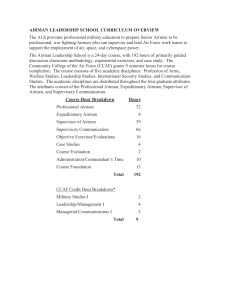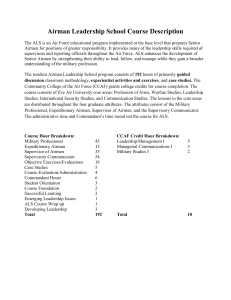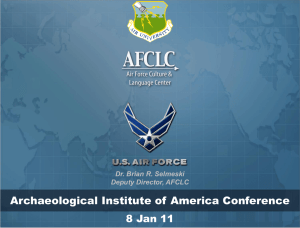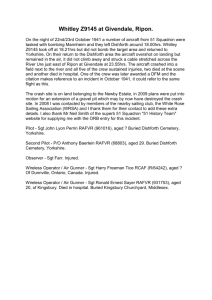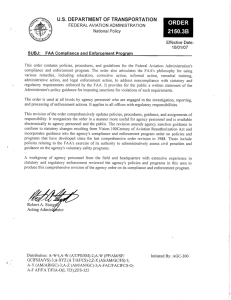Bagram Bullet - d2.static.dvidshub.net
advertisement
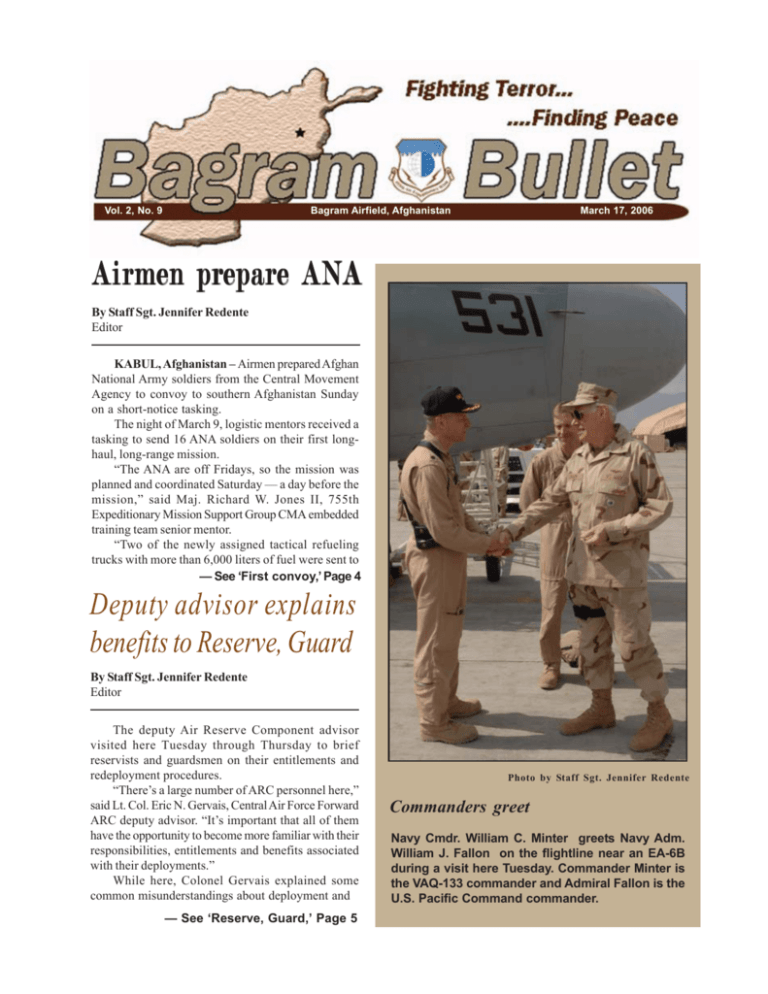
Vol. 2, No. 9 Bagram Airfield, Afghanistan March 17, 2006 Airmen prepare ANA By Staff Sgt. Jennifer Redente Editor KABUL, Afghanistan – Airmen prepared Afghan National Army soldiers from the Central Movement Agency to convoy to southern Afghanistan Sunday on a short-notice tasking. The night of March 9, logistic mentors received a tasking to send 16 ANA soldiers on their first longhaul, long-range mission. “The ANA are off Fridays, so the mission was planned and coordinated Saturday — a day before the mission,” said Maj. Richard W. Jones II, 755th Expeditionary Mission Support Group CMA embedded training team senior mentor. “Two of the newly assigned tactical refueling trucks with more than 6,000 liters of fuel were sent to — See ‘First convoy,’ Page 4 Deputy advisor explains benefits to Reserve, Guard By Staff Sgt. Jennifer Redente Editor The deputy Air Reserve Component advisor visited here Tuesday through Thursday to brief reservists and guardsmen on their entitlements and redeployment procedures. “There’s a large number of ARC personnel here,” said Lt. Col. Eric N. Gervais, Central Air Force Forward ARC deputy advisor. “It’s important that all of them have the opportunity to become more familiar with their responsibilities, entitlements and benefits associated with their deployments.” While here, Colonel Gervais explained some common misunderstandings about deployment and — See ‘Reserve, Guard,’ Page 5 Photo by Staff Sgt. Jennifer Redente Commanders greet Navy Cmdr. William C. Minter greets Navy Adm. William J. Fallon on the flightline near an EA-6B during a visit here Tuesday. Commander Minter is the VAQ-133 commander and Admiral Fallon is the U.S. Pacific Command commander. 2 Bagram Bullet Fighting Terror, Finding Peace March 17, 2006 Commander explains importance of innovation By Maj. J. Scott Sanford 455th Expeditionary Security Forces Squadron commander solutions to real problems requires hard thought and innovative ideas. If a jet engine mechanic comes up with a fix to a problem that isn’t in the technical order, that person has innovated a new solution. The logistician who must We are an extremely precise, effective fighting force. In immediately get critical supplies to a remote location will fact, we’re the most lethal air, land and sea combat force in probably have to work outside the normal operating the world. I offer you some suggestions on why this is and guidelines to get the results needed. Do we disregard mission how we can maintain this awesome effectiveness for years to instructions and the orders provided to us? No, we simply come. No, I won’t use words like “transformation,” “combat come up with new ways of doing business that make the agility,” or any of those impressive phrases we hear so often mission, and our military, better. in the news. While these terms represent important Thinking inside the box means accepting the status quo, initiatives in today’s military, I can provide and that doesn’t make organizations, or people, more common examples to help make this great. Retired men in Florida represent the perfect point. example of maintaining the status quo. Have you Football coach Knute Rockne got the ever noticed that many retired men in Florida idea for Notre Dame’s “four horsemen” wear their pants up to their chests? There is a formation while watching a dance simple reason for this behavior. Most retired men performance. World War I military wear their pants up to their chests because when designers borrowed from the cubist art of they age, they shrink. Because these men are Picasso to create better camouflage reluctant to change, a bit like not thinking outside patterns. The unbreakable U.S. military the box, they never buy new pants. code used in World War II was derived Creating innovative solutions to problems from the Navajo language. As the above isn’t just the work of engineers and inventors; we examples illustrate, when you encourage have opportunities every day to improve our people to think outside the box you help work. Our men and women use their knowledge build more effective processes and of regulations and instructions, but go a step Major Sanford organizations. further and develop really creative, smart ideas Today’s military is highly complex. that work. Innovation, continuous improvement Orchestrating air, space and ground assets for “on target” and adapting to change are the key ingredients that I suggest results depends on the creative approaches to the problems make our military the best fighting force in the world. that confront us all. Operating “out of the box” is more than Ask those who work with you each day and also ask just a catch phrase. Consider how many “boxes” we have in yourself: How can we make our jobs easier? What can we do our military: technical orders, regulations, operating to make things work better? If you reward this kind of instructions, policy directives. While all of these boxes serve thinking in your work centers you’ll, be both proud and as strong foundations for our training and expertise, getting surprised at the results. Bagram Bullet Editorial Staff, Disclaimer Brig. Gen. Bruce Burda ….…......……..…. Commander, 455th AEW Maj. Eric Elliott ………….........................… Chief, Public Affairs Staff Sgt. Jennifer Redente ….....… Editor/NCOIC, Public Affairs This newspaper is an authorized publication for Airmen and Sailors deployed to Bagram Airfield, Afghanistan. Contents of the Bagram Bullet are not necessarily the official views of, or endorsed by, the U.S. Government or the Department of Defense. The editorial content is edited, prepared and provided by the 455th Air Expeditionary Wing Public Affairs office. FIN NANCE 3 Bagram Bullet Fighting Terror, Finding Peace March 17, 2006 Safety chief reflects on Bagram challenges By Lt. Col. Neil E. Woods 455th Air Expeditionary Wing Safety chief I still remember a phrase my father repeated often when I was a young boy— “Anything worth doing is worth doing well.” Throughout my life I’ve tried to live by that wise principle, and I’ll try to pass that same wisdom to my own children. Most of the time, we gauge “doing well” by the measure of success in our accomplishments and those positive things that happen as a result of our actions. We love to build things, complete a mission, win a sports event, lead an award winning organization and get promoted to the next level. However, the world of safety us different. Safety isn’t measurable, and those things we try to measure are in the “don’t” category rather than the “do.” In safety, we only feel successful if airplanes don’t crash, vehicles don’t roll over, weapons don’t fire or explode unintentionally and people don’t get hurt. Even then we still doubt bad things didn’t happen because of something Safety did. Rather, we attribute it to the great risk management principles and professionalism of those we serve—and rightly so. The deployed environment adds a significantly greater challenge in the business of measuring “don’ts.” I couldn’t have imagined the host of safety issues that make up every day here. I’m normally an eternal optimist, but I’m amazed more bad things don’t happen here. Never as the Vance Air Patch Safety chief could I use a large piece of the runway as a paperweight on my desk, see 10 ton dump trucks using flightline road as a raceway or witness a contractor put up an 8-foot fence right next to an active taxiway because that’s what the drawing said to do. How frustrating it is to see a runway infield littered with trash and not be able to clean it up for fear of losing parts of my anatomy to a land mine. I haven’t even begun to mention the hazards just walking around the base—holes, rocks, vehicle congestion and pitch black street corners that beckon disaster for unwary pedestrians. Let’s face it, if Bagram was any air base in the United States, it would have been closed a long time ago. o what’s the difference here? Well, that’s pretty obvious to Bagram’s freedom defenders. Safety isn’t paramount here, but the mission sure is, and along with the professionalism we brought with us to do all things like we were trained. We accept more risk and we expect our people to apply skill and professionalism to get the job done in a tough environment, while preventing avoidable injuries and taking care of our equipment. I meet some truly professional Airmen, Soldiers and civilians every day who love what they’re doing, are proud of their work and know what they’re doing is worth S doing well because it’s making a difference in the world. I ate dinner with members of our explosive ordnance disposal team recently and was so impressed by their motivation, professional bearing and enthusiasm despite multiple deployments and some really tough work in some really nasty places. They know their lives and limbs, much more so than most of us, depend on doing things well, and they do it gladly with pride. o, I haven’t observed the safety lamented “cowboy mentality” here. Instead, I’ve seen commitment to doing things the right way and continuous movement toward higher degrees of safety as we transition from a bullets flying combat operation to more normalized function. Let’s keep that safety “don’t” list long and the “do” list short, and stay committed to doing things well and making Bagram a safer place than when we came. N 4 Bagram Bullet Fighting Terror, Finding Peace March 17, 2006 Air Force trains Afghan National Army CMA soldiers deploy on two-month mission First convoy From Page 1 an ANA forward operating base near Kandahar in support of combat operations,” Major Jones said. “Most of our drivers had never even driven a vehicle before receiving training from us,” said Master Sgt. Jonathan W. Tucker, 755th EMSG ETT vehicle operations mentor. “We have taken them from nondrivers to successfully driving refueling trucks and other medium tactical vehicles.” Four of the 16 ANA soldiers will remain on a two-month deployment to support forward operating bases near Kandahar, said Major Jones. “The FOBs desperately need fuel and local contractors find it too dangerous to deliver there, but CMA rose to the challenge,” the major said. “Though it was short-notice, they were ready.” Major Jones briefed the 16 ANA soldiers before their departure and ensured the vehicles had been properly prepared for the mission. “I felt it was important to brief the concept of the operations including weapon readiness, actions on contact with the enemy, rally points, travel speed and breakdown procedures,” the major said. “I wanted every ANA troop to know the full plan in case of enemy contact and separation. “Two months ago when we arrived, the CMA had no vehicles and the troops were living in the cabs of old trucks,” Major Jones added. “Now we have a brand new fleet of vehicles and have moved into new buildings. ANA is becoming a self-sustaining force, no longer relying on local contractors, but making nationwide movements on their own. This is really a very significant event.” Embedded training teams assigned to the 755th EMSG first arrived in January to train ANA soldiers how to properly operate low- and medium-terrain vehicles. Photo by Staff Sgt. Jennifer Redente KABUL, Afghanistan — Preparing for the Afghanistan National Army Central Movement Agency’s first convoy mission, Maj. Richard W. Jones II, briefs ANA soldiers on the route they will take to reach their destination. Major Jones is the senior mentor assigned to the 755th Expeditionary Mission Support Group CMA Embedded Training Team. 5 Bagram Bullet Fighting Terror, Finding Peace March 17, 2006 ARC briefs guardsmen, reservists Brief Bullets Reserve, Guard Col. John R. Buckingham, 455th Air Expeditionary Wing vice commander, was recently appointed as the Inspector General local liaison. Personnel wishing to file an IG complaint may do so at any level without the fear of reprisal. Airmen wishing to contact the IG liaison may call 231-4037. For guidance on proper filing procedures and policy, members should refer toAir Force Instruction, Inspector General Complaints Resolution, 90-301. From Page 1 redeployment dates, legal and regulatory issues. “Guardsmen and reservists need to understand that regardless of when they were actually in place, their time starts based on their required delivery date,” the ARC deputy advisor said. “Contingency, exercise and deployment orders are sometimes incorrect, so the best thing for them to do is to contact their Personnel Support for Contingency Operations office or their Unit Deployment Manager for the correct RDD and their temporary duty expiration date.” Briefings by the advisor also included information on special duty payments and programs available to guardsmen and reservists while deployed. “I wanted to make sure everyone is aware of benefits and entitlements associated with their service,” he said. “Most deployed Guard and Reserve personnel are unaware of how significant their support is to CENTAF’s mission,” Colonel Gervais said. “Our presence here ensures that we maintain an active role in the support and defense of freedom both at home and abroad. “Our support of the mission also helps share the deployment burden and decreases the active duty Air Force operations tempo,” he said. Guardsmen and reservists can reach CENTAF Forward ARC advisors by calling DSN 318-438-4009, or by e-mail at CENTAF.ARC@AUAB.CENTAF.AF.MIL. Comm tip of the week Proper care of land mobile radios: • Never place a radio in the charger while it is on. • Avoid using the antenna as a handle. Congratulations to the newest Below The Zone recipients: IG complaints SARC Camp Cunningham has a sexual assault response coordinator assigned here. The 455th Air Expeditionary Wing has a zero tolerance policy on sexual assault. People wishing to contact the SARC for more information, or to report a sexual assault, may contact Capt. Henry Alexander, 455th AEW’s Sexual Assault Response Coordinator. His office is in bldg. 737 on Camp Cunningham, and he can be reached at 231-2245. Laundry service KBR offers a free laundry service Mondays, Wednesdays and Fridays. This is limited to 20 items including the bag. Personnel should take bags and completed DA Form 2886 to the Services tent by 1000L. For more information, call Master Sgt. Rick Stiles at 231-4360. MTA meeting Gregory S. Gibbs Jayson B. Hernandez Bobby P. McCrary The next Middle TierAssociation meeting is scheduled for 0900LWednesday in Rec Tent. The Middle TierAssociation is for staff and technical sergeants who want to be involved in morale functions here. 6 Bagram Bullet Fighting Terror, Finding Peace March 17, 2006 Events MTA A volleyball tournament sponsored by the Middle Tier Association is scheduled for Sunday. There will be a barbeque, and the first sergeants and chiefs will play the colonels at noon while tournament participants eat. Team captains will meet at the Oasis at 0930L. The first game will start at 1000L. ACE A three-on-three basketball tournament hosted by the Airmen Committed to Excellence, is scheduled for March 26. The tournament will start at 1000L. A $3 donation is requested for those who would like to participate. Teams sign up in the Services tent. Photo by Staff Sgt. Jennifer Redente Aircraft artwork Bug-out bash Air Expeditionary Force 9 and 10 will hold a barbeque and sports day April 23. Master Sgt. Michael B. Phillips uses chalk to draw the 774th Expeditionary Airlift Squadron mascot on the side of a C-130 here. Sergeant Phillips is assigned to the 455th Expeditionary Aircraft Maintenance Squadron as a C-130 non destructive tester. He is deployed here from Kulis Air National Guard, Alaska. Expensive sunglasses don’t pass as ballistic eyewear FOD check Sixteen percent of all coalition force during work projects since they exceed the sunglasses they are wearing are correct for the tasks being performed. Expensive causalities attributed eye injuries. standards set by thethe American National Beforeare entering thetoflightline, it’s mandatory to check tread of the tires to ensure there are no rocks being tracked sunglasses rarely pass as safety The eye protection Standards Institute. intouse the of flightline. This isisarequired safety aspect for aircraft and personnel. If personnel are seen entering the flightlineeyewear, without less ballistic eyewear. If there isn’t an during field tactical operations, Military eyewearbeisstopped tested to ballistic and much performing a foreign objecttraining debris check, they should and corrected immediately. ANSI 87.2 stamped on the frame or lenses or situations where there is risk of optical standards, so don’t be fooled thinking themselves, see a supervisor to get the right combat. Ballistic eye glasses can also be $12 sunglasses will do the trick.Airmen should tool for the job. used as impact resistant safety glasses check with their supervisor to ensure the 7 Bagram Bullet Fighting Terror, Finding Peace March 17, 2006 Munitions system specialists process ammo Photo by Staff Sgt. Jennifer Redente Raising his hand, Senior Airman Andrew W. Brown, left, signals Staff Sgt. Louis P. Jorae, back right, to stop the GFU-7 ammunition loader assembly. Airman 1st Class Keith R. Burns, back left, spoons 30 mm rounds into container. As the shells pass Airman 1st Class Jose R. Herrera, right, he checks to ensure the round counter is working correctly. The Airmen are assigned to the 455th Expeditionary Maintenance Squadron as munitions systems crewmembers. The Airmen use the system to process ammunition. While processing ammunition, Airman Brown replaces ties on a link tube carrier. Senior Airman Andrew W. Brown replaces ties on a link tube carrier as Airman 1st Class Jose R. Herrera hands for ties to Airman 1st Class Keith R. Burns. They deployed here from Eielson Air Force Base, Alaska. 8 Bagram Bullet Fighting Terror, Finding Peace March 17, 2006 Open nose Senior Airman Steven Cherry prepares to change the radar antenna in the nose of a C-130. Airman Cherry is assigned to the 455th Expeditionary Aircraft Maintenance Squadron as an avionics specialists. He is deployed here from Kulis Air National Guard, Alaska. Photo by Staff Sgt. Jennifer Redente 9 Bagram Bullet Fighting Terror, Finding Peace March 17, 2006 Bagram’s Best Airman Dillon, below, is deployed here as an A-10 Thunderbolt II crew chief specifically for the 355th Expeditionary Fighter Squadron commander’s aircraft. He is assigned to the 455th Expeditionary Aircraft Maintenance Squadron. Originally from Slidell, La., Airman Dillon’s home station is Eielson Air Force Base, Alaska. The crew chief hopes to finish his airframe and power plant license, as well as his aeronautics degree while serving in the Air Force. Airman 1st Class Justin S. Dillon Tech. Sgt. Jeffrey S. Wheeler Sergeant Wheeler, above, is deployed here as the computer systems administration noncommissioned officer in charge with the 455th Expeditionary Mission Support Squadron. He is from the United States Air Force Europe Computer Systems Squadron, Ramstein Air Base, Germany. The Winter Park, Fla., native hopes to make master sergeant and complete his second master’s degree.
